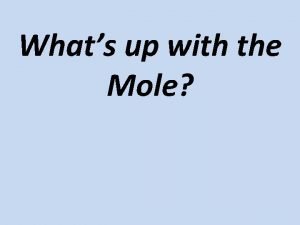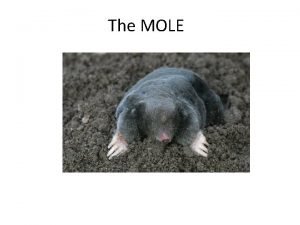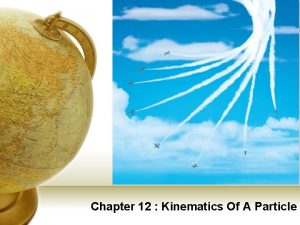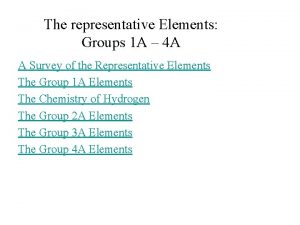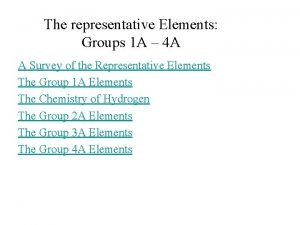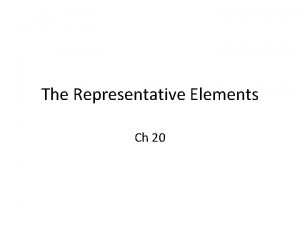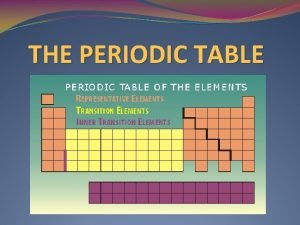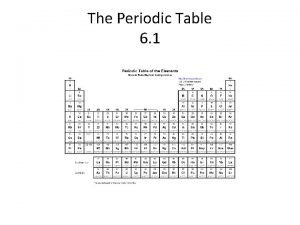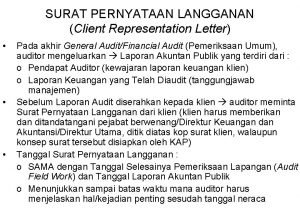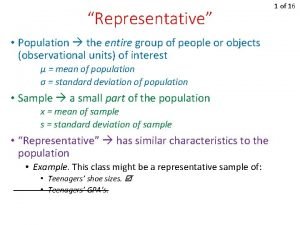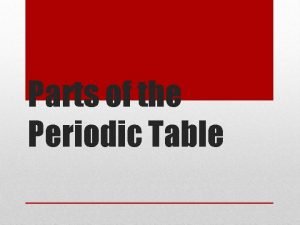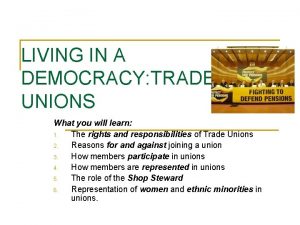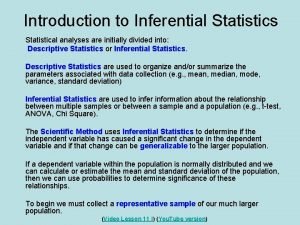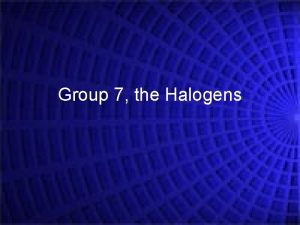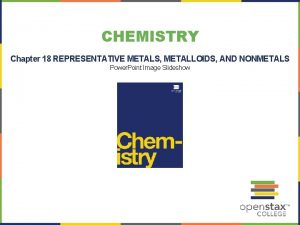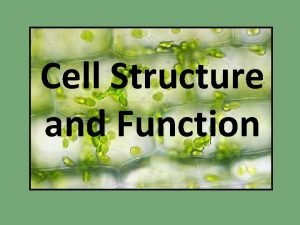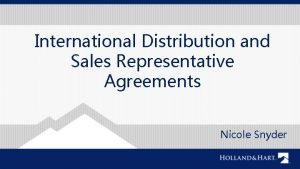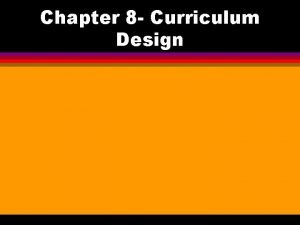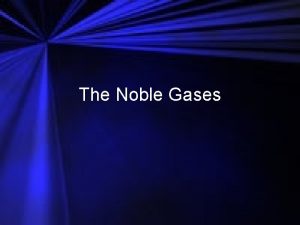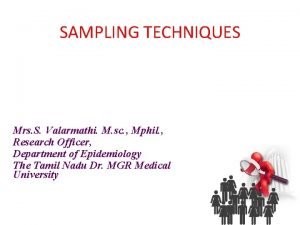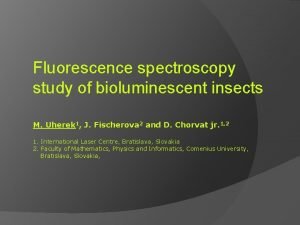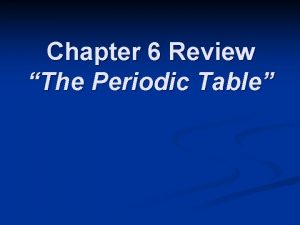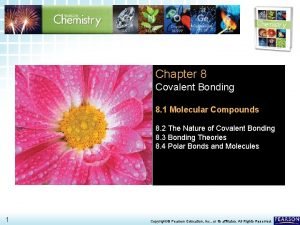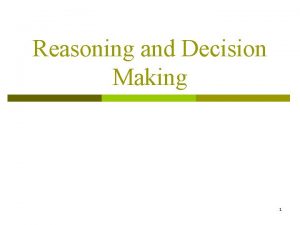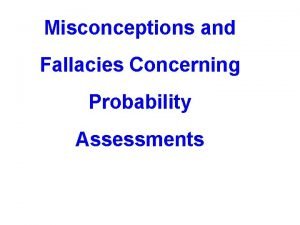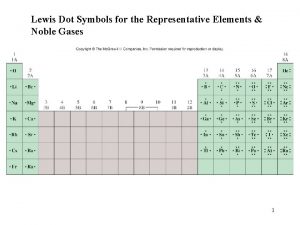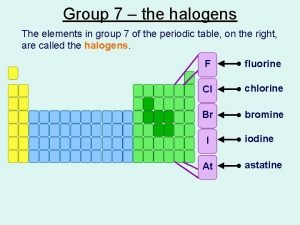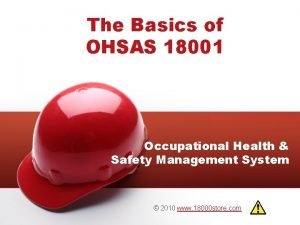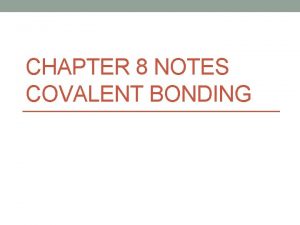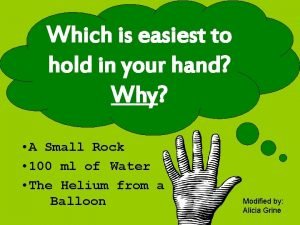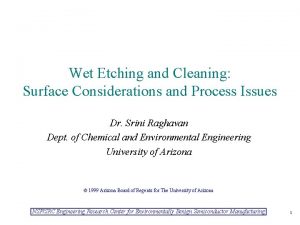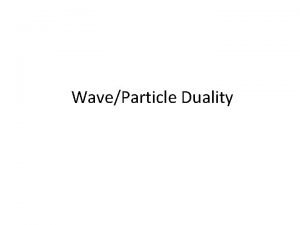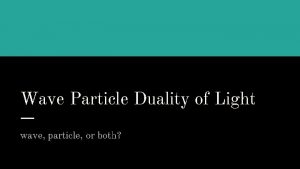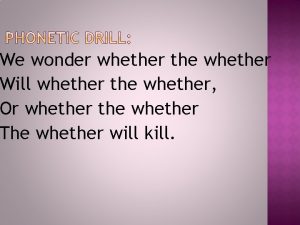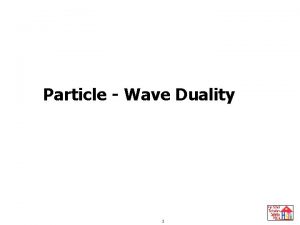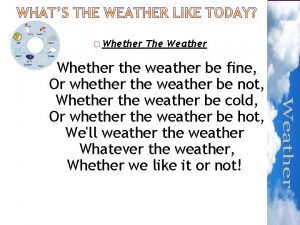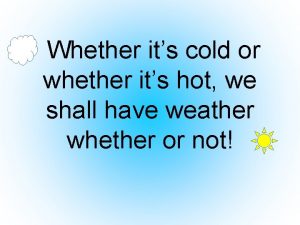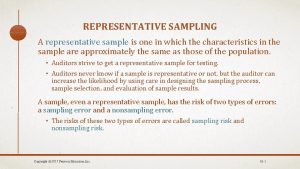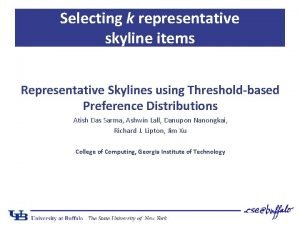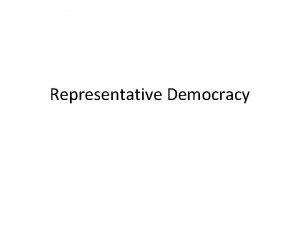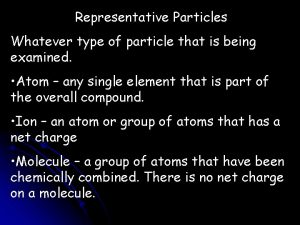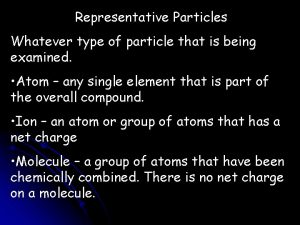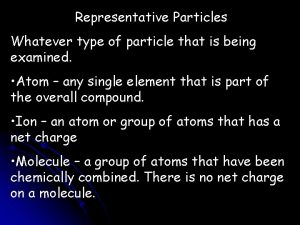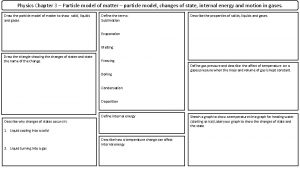Chapter 7 n Representative particle refers to whether






































































- Slides: 70

Chapter 7

n Representative particle- refers to whether a substance commonly exists as atoms, ions, or molecules n Ex. Elements- Representative Particle is the atom

n 7 elements exist as diatomic molecules n H 2 N 2 O 2 F 2 Cl 2 Br 2 I 2 n. Representative Particle of a molecular compound is a molecule Example CO SO 3

Formula unit (FU) -Representative Particle of ionic compounds Example Na. Cl Ag. NO 3 Ba. S Ca(C 2 H 3 O 2)2

n Mole- Chemists quantity of a substance that represents 6. 02 x 1023 representative particles of that substance- called Avagadro’s number n ex. 1 dozen eggs n How many moles of Mg atoms in 3. 01 x 1022 atoms of Mg? n# of moles in 1. 20 x 1025 atoms of P?

n# of atoms in. 750 mol of Zn? n# of molecules in 4 mol of glucose, C 6 H 12 O 6? n# of moles in 1. 20 x 1024 molecules of CO 2 ?

n To find the # of atoms in 1 mole of a compound, you must determine the # of atoms in a representative formula of that compound

n# of fluoride ions in 1. 46 mol of Aluminum fluoride? n# of C atoms in a mixture of 3 mol C 2 H 2 and. 7 mol carbon monoxide?

n Atomic Mass – amu n Mass of single atom n Ex) C = 12 amu n Ex) H = 1 amu (Periodic Table)

n Gram Atomic Mass – gam n # of grams of an element that is numerically equal to the atomic mass in amu. n Ex) Carbon – gam is 12 g n Ex) Oxygen – gam is 16 g

n GAM – mass of 1 mol of atoms of a mono-atomic element n Ex) Carbon – gam is 12 g/mol n Ex) Oxygen – gam is 16 g/mol

n GMM – mass of 1 mol of that compound. n Ex) GMM of H 2 O 2

2 mol H x 1 g. H 1 mol H 2 mol O x 16. 0 g O 1 mol O = 2. 0 g H = 32. 0 g O 34 g

Examples n Find the GMM of C 6 H 4 Cl 2

n n n C H Cl 6 x 12. 01 = 72. 06 4 x 1 = 4 2 x 35. 45 = 70. 9 146. 96 g

n GFM – Mass of 1 mol of an ionic compound. n Ex) GFM of Ammonium Carbonate

2 mol N x 8 mol H x 1 mol C x 3 mol O x 14 g. N 1 mol N 1 g. H 1 mol H 12 g C 1 mol C 16 g O 1 mol O = 28 g = 8 g = 12 g = 48 g 96 g

Molar Mass n Mass of a mole of any element or compound. n. Ex) O 2 = 32 g/mol, n. O = 16 g/mol

Mole Mass Conversion Ex) # of grams in 7. 20 mole of dinitrogen trioxide n

2 mol N x 3 mol O x 14 g N 1 mol N 16 g O 1 mol O = 28 g N = 48 g O 76 g

Example Cont’d… 7. 20 mol N 2 O 3 x 76 g N 2 O 3 1 mol N 2 O 3 = 5. 47 x 102 g N 2 O 3

Grams n Moles Ex) find # of moles 922 g of iron(III) oxide.

922 g Fe 2 O 3 x 1 mol Fe 2 O 3 159. 6 g Fe 2 O 3 = 5. 78 mol Fe 2 O 3

n The Volume of a gas at Standard Temperature and Pressure is 22. 4 L (STP). n Std Temp = 0°C n Std Press = 1 atmosphere (atm) n 22. 4 = molar volume of a gas = 22. 4 L 1 mol

n Ex) Determine the Volume in L of 0. 600 mol of Sulfur Dioxide gas @ STP. n Mol L n Known : 1 mol SO 2 = 22. 4 L

. 600 mol SO 2 x 22. 4 L 1 mol SO 2 = 13. 4 L SO 2

n n Gas Density and Gram Molecular Mass Density of gas – units g/L Ex. Density of carbon and oxygen is 1. 969 g/L at STP. Determine gfm. Is compound CO or CO 2 ? Densities of A, B, and C are 1. 25, 2. 86, and. 714 g/L at STP. Calculate gfm of each. Identify each substance as ammonia, sulfur dioxide, chlorine, nitrogen or methane.

Volume of gas at STP Representative 1 mol/ 22. 4 L 1 mol/6. 02 x 1023 part 22. 4 L/ 1 mol particles 6. 02 x 1023 part/ 1 mol Mole 1 mol/gfm gfm/ 1 mol Mass

n Ex. How many Carbon atoms are in a 50 carat diamond that is pure carbon? n n n 50 carats= 10 g Mass in grams of an atom of nickel? How many molecules are in a 6 L balloon filled with carbon dioxide (@ STP)?

Percent Composition n the percent by mass of each element in a compound.

Examples n Find the percent composition of K 2 Cr. O 4

% mass = grams of element x 100 grams of compound

n 40. 3 %K n 26. 8 % Cr n 32. 9 % O n They must add up to equal 100%

Example n An 8. 20 g piece of Mg combines completely with 5. 40 g of oxygen to form a compound. Calculate the % composition of the compound.

8. 20 g + 5. 40 g = 13. 60 g % Mg = mass of Mg x mass of compound 8. 2 x 13. 6 100 = 60. 3% 100

Cont’d %O = mass of O x 100 mass of compound = 5. 40 13. 6 x 100 = 39. 7%

Example n 29 g of silver combines with 4. 3 g of sulfur. Calculate % composition.

29 x 33. 3 4. 3 x 33. 3 100 = 87. 1% Ag = 12. 9%S

Example n 222. 6 g of Sodium combines with 77. 4 g of Oxygen. Calculate % composition.

222. 6 300 x 100 = 74. 2 % Na 77. 4 300 x 100 = 25. 8% O

% Composition of a known compound % mass = grams of element in 1 mol of cmpd x 100 gfm of compound

Examples n Calculate the % composition of ethane, C 2 H 6.

Cont’d n. C n. H - 2 x 12 = 24 g 6 x 1 = 6 g 30 g

Cont’d 24 30 x 100 = 80 % C 6 30 x 100 = 20 % H

Examples n Calculate the % composition of: na) C 3 H 8 nb) Calcium Acetate nc) Hydrogen Cyanide

n a) 81. 8%C, 18. 2% H n b) 25. 4% Ca, 30. 4% C, 3. 8% H, 40. 5% O n c) 3. 7% H, 44. 4% C, 51. 9% N

Examples n Calculate the mass of Carbon in 82 g of C 2 H 6.

82 g C 2 H 6 x 80 g C = 66 g C 100 g C 2 H 6 *Based on previous example, Composition of C in C 2 H 6 is 80% C & 20% H

Examples n Calculate the amount of Hydrogen in the following compounds.

350 g C 3 H 8 x 18. 2 g H 100 g C 3 H 8 63. 7 g H =

124 g Calcium Acetate 124 g Ca(OAc)2 4. 71 g H x 3. 8 g H = 100 g Ca(OAc)2

378 g Hydrogen Cyanide 378 g HCN x 3. 7 g H = 100 g HCN 14 g H

Empirical Formulas

Empirical Formula n The lowest whole number ratio of the element in a compound.

n An empirical formula may not be the same as the molecular formula n Examples n CO 2 is both empirical and molecular n N 2 H 4 is molecular formula n NH 2 is empirical formula because it is the simplest ratio of N : H

Examples n Find the empirical formula of a compound that is 25. 9% nitrogen and 74. 1% oxygen.

25. 9 g N x 1 mol N 14 g N = 1. 85 mol N 74. 1 g O x = 4. 63 mol O 16 g O

1. 85 mol = 1 mol N 4. 63 mol 1. 85 mol = 2. 5 mol O

N) 1 x 2 = 2 O) 2. 5 x 2 = 5 empirical formula - N 2 O 5

Examples n Find the empirical formulas for the following compounds.

79. 8 %C , 20. 2 %H n. Empirical CH 3 Formula

67. 6% Mercury , 10. 8% Sulfur, 21. 6% Oxygen n Empirical Formula Hg. SO 4

17. 6% Sodium, 39. 7% Chromium, 42. 7% Oxygen n Empirical Formula Na 2 Cr 2 O 7

Calculating Molecular Formulas n You must know: n. Empirical Formula n. GFM

Examples -gfm = 60 g -Empirical formula = CH 4 N -efm = 30 gfm = 60 = 2 efm 30 2(CH 4 N) = C 2 H 8 N 2

n gfm = 181. 5 g n Empirical formula = C 2 HCl n efm = 60. 5 gfm = 181. 5 = 3 efm 60. 5 3(C 2 HCl) = C 6 H 3 Cl 3

Methyl butanoate smells like apples. The Percent Composition is 58. 8% C, 9. 8%H, 31. 4% O. The gfm is 102 g/mol - what is the molecular formula?

58. 8 g. C x 1 mol C = 4. 9 mol C 12 g C 9. 8 g. H x 1 mol H = 9. 8 mol H 1 g H 31. 4 g. O x 1 mol O = 1. 96 mol O 16 g O

4. 9 1. 96 = 2. 5 mol C 9. 8 1. 96 = 5 mol H 1. 96 = 1 mol O

C) 2. 5 x 2 = 5 H) 5 x 2 = 10 0) 1 x 2 = 2 C 5 H 1002
 What is not a representative particle
What is not a representative particle What is the representative particle for an element
What is the representative particle for an element Representative particle
Representative particle Representative particle
Representative particle Si base unit
Si base unit Weather vs whether
Weather vs whether Function of emotions
Function of emotions Chapter 12 kinematics of a particle solutions
Chapter 12 kinematics of a particle solutions Availability heuristic
Availability heuristic Representative metal
Representative metal Where are representative elements on the periodic table
Where are representative elements on the periodic table Represenative elements
Represenative elements Periodic table of elements outline
Periodic table of elements outline Gain lose electrons periodic table
Gain lose electrons periodic table Isi dari client representation letter
Isi dari client representation letter Representative sample example
Representative sample example Representative elements
Representative elements Representative elements periodic table
Representative elements periodic table Examples of representative money
Examples of representative money Trade union representation
Trade union representation Representative sample in statistics
Representative sample in statistics Sployochyg
Sployochyg Why does the reactivity decrease in group 7
Why does the reactivity decrease in group 7 Dichotomous key to representative birds
Dichotomous key to representative birds Fiat currency example
Fiat currency example Representative democracy examples
Representative democracy examples Representativeness heuristic
Representativeness heuristic Representative metal
Representative metal Representative plant cell
Representative plant cell Participatory democracy definition ap gov
Participatory democracy definition ap gov The length of an aerial is representative of:
The length of an aerial is representative of: Chapter 9 chemical names and formulas chapter quiz answers
Chapter 9 chemical names and formulas chapter quiz answers What is china national animal
What is china national animal International sales representative agreement
International sales representative agreement Dichotomous key
Dichotomous key Ap stats experimental design
Ap stats experimental design Political cartoons about democracy
Political cartoons about democracy What is a charter organization
What is a charter organization Learner centered design strengths and weaknesses
Learner centered design strengths and weaknesses Www.ausa.org
Www.ausa.org Are noble gases representative elements
Are noble gases representative elements Volunteer sample vs convenience sample
Volunteer sample vs convenience sample Data controller representative turkey
Data controller representative turkey Glowworm representative species
Glowworm representative species Direct democracy cartoons
Direct democracy cartoons What is another name for the representative elements
What is another name for the representative elements Principles of representative democracy
Principles of representative democracy What is the representative unit of an ionic compound
What is the representative unit of an ionic compound What is representative democracy
What is representative democracy Gsa drive-thru login
Gsa drive-thru login Representative heuristic
Representative heuristic Representative church body
Representative church body Declarative speech act definition
Declarative speech act definition P ways
P ways Representative heuristic
Representative heuristic Ch3ccch3 lewis structure
Ch3ccch3 lewis structure The practice in congress whereby representative a
The practice in congress whereby representative a Why does the reactivity decrease in group 7
Why does the reactivity decrease in group 7 Representative money definition
Representative money definition A plain scale of 1cm=5m and show on it 37m
A plain scale of 1cm=5m and show on it 37m Wellcare provider relations representative
Wellcare provider relations representative Ohsas 18001 management representative appointment
Ohsas 18001 management representative appointment Senior legislative representative
Senior legislative representative Mount diablo silverado council
Mount diablo silverado council Characteristics of covalent bond
Characteristics of covalent bond Aota representative assembly
Aota representative assembly Market america sales representative
Market america sales representative Solid+heat
Solid+heat Wet etch clean and filter
Wet etch clean and filter Wave particle duality questions
Wave particle duality questions What is a particle
What is a particle



